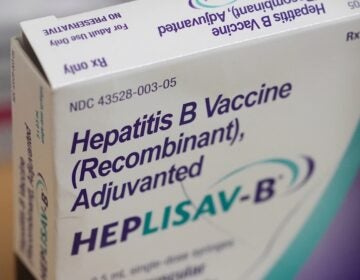Should N.J. demand better public access for beaches repaired with Sandy funds?
Listen-

-

-

-

-

-

-

-

Roosevelt’s Cynthia Byron talks with sixth grader Zymeer Mcleod who helped put on the the Positive Behavior Intervention Supports (PBIS) presentation earlier in the day. (Brad Larrison/for NewsWorks)
Some say coastal communities taking federal money to bankroll beach replenishment projects should be forced to make their beaches easily accessible to the public.
The state of New Jersey and the U.S. Army Corps of Engineers are in the process of building protective dunes along the Shore and widening many of its beaches, hoping to protect the coastline more effectively from future storms.
Because those projects are bankrolled with federal Sandy relief funds, some say coastal communities taking the money should be forced to make sure all of their beaches are easily accessible to the public.
“We should make certain that public access is a part of what we do, as opposed to allowing towns to get public dollars, do the enhancements to their beach, but then not have the ability in a very real way for people to access the beach,” said state Sen. Jim Whelan (D-Atlantic County).
He’s sponsored a bill to require that the state’s shore protection projects include public access to the waterfront, including the “beach nourishment projects” that are a part of Sandy recovery.
“The public needs to be guaranteed access to the beaches that are built with that money,” agreed Tim Dillingham, director of the American Littoral Society, an organization focused on coastal issues.
Many New Jersey towns actively court residents from other parts of the state and beyond. They want tourists to come to their beaches and boardwalks, to buy beach tags and ice cream cones. So they try to make getting onto the beach easy with lots of access points, parking and bathrooms.
“And then there’s the other 40 percent of the coastline, which are in residential communities, which don’t want to have people who don’t live there come,” said Dillingham.
By way of example, he cites a handful of streets in Deal, N.J., north of Asbury Park, which dead-end into beaches. Many have landscaping or other barriers that block public access to the water and restricted parking. One ends with a waist-high cement wall.
Dillingham would like to see the town remove that wall and build a set of stairs to the beach, especially since the strip of sand below will be significantly wider once the Army Corps finishes a “beach nourishment” project here.
“So there’ll be a nice beautiful beach here that no one will be able to get to besides the people who live right next to it,” said Dillingham.
Whelan, D-Atlantic, expects his bill would only impact a handful of communities, though he declined to specify which communities need better access.
“The South Jersey Shore communities are pretty good [with respect to access],” he said. “The issue comes up a little more in some of the, frankly, more upscale communities in northern Jersey, where they have had more limited access to the beach.”
State plan offers towns flexibility
Larry Ragonese, a spokesman for the Department of Environmental Protection, counters that the state already has a good public access plan; it’s only a year and a half old and gives towns the flexibility to decide what kind of access to offer. The New Jersey courts stuck down a previous law which mandated access at prescribed intervals.
“Instead of government coming in and slamming down the hammer and saying you must put this, in every 30 yards you must have something, we said, ‘Hey, Town X, what makes sense for you?’” said Ragonese.
Efforts to improve access stalled last year while the state was so focused on rebuilding from Sandy, he admitted. But the DEP is working on it, Ragonese said, citing new access, parking, and bathrooms in Loveladies, on Long Beach Island, for example. Linden just submitted a new access plan for the DEP’s review.
“If a town doesn’t provide real access, of course, we always have the option of taking legal action against the town,” said Ragonese. “They’re required to provide public access and good public access.”
But he thinks that by giving the communities a say in the planning, it won’t come to that.
Dillingham, with the Littoral Society, doesn’t agree.
“They really have tried to bait and switch very strong, legally enforceable requirements to provide public access with a very soft program that is voluntary and puts responsibility in the hands of people in these towns who have been hostile to put access for years and years,” he said.
Whelan’s bill is currently under review by the Senate Banking Committee, but its chances are still uncertain. Gov. Chris Christie vetoed a similar bill last year.
WHYY is your source for fact-based, in-depth journalism and information. As a nonprofit organization, we rely on financial support from readers like you. Please give today.




